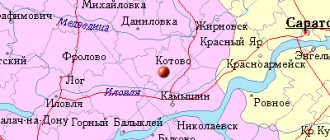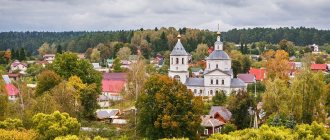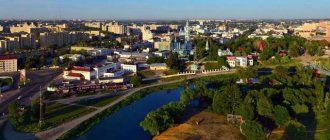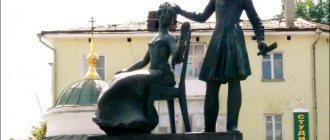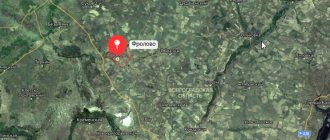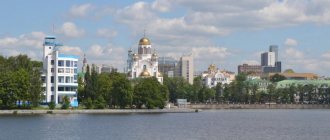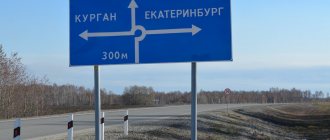Vichuga
The city of Vichuga was formed in 1925 by uniting 3 large factory villages: Tezino, Bonyachki and Novaya Golchikha, as well as 24 nearby towns and villages. Vichuga lands in the 1st millennium
From ancient times to the end of the 1st millennium AD. The Vichuga lands were inhabited by representatives of the Finno-Ugric tribe Merya. Hunting and fishing were their main activities. The heritage of the Merians is, in particular, many geographical names. For example, Vichuga means “swampy lowland”, Volga means “river flowing through the lowland”, Sunzha means “quiet water”.
Slavic tribes appeared on the Vichug lands in the 10th century; the Krivichi and Ilmen Slovenes settled here, over time peacefully merging with the Finns and passing on to them their skills in cattle breeding, agriculture and crafts. At this time, Slavic names began to appear, mainly for villages and villages: Zolotilovo, Semigorye, Zarubino, Sinye Gari, Chertovischi, Kamenka, Golchikha and others.
First information about Vichuga
The first mention of the name Vichuga in written sources dates back to 1482. In the letter of grant, dated this year, from the Grand Duke of Moscow Ivan III Vasilyevich to Prince Belsky, the husband of his niece, it is written: “I granted the prince Fyodor Ivanovich Belsky, gave him the city of Lukh with its volosts, and the volosts of Vichuga and Kineshma as his patrimony.”
. From the text of the charter it follows that Vichuga at that time was already a volost, i.e. a significant territory (it is mentioned in the document before Kineshma), with an administrative center - the village of the same name (now it is Staraya Vichuga). And the surname of the princely and boyar family of the Belskys is still preserved by the name of the village of Zabelskoye, Vichuga region, which in the 15th century, presumably, could have been the border of the lands held “beyond the Belskys”.
The Belskys owned the Vichuga lands until the oprichnina was introduced by Ivan IV the Terrible in 1565, after which these lands were classified as grand ducal lands. At the beginning of the 17th century, the Vichuga volost became part of the newly formed Kineshma district. Compared to the vast neighboring districts - Kostroma and Suzdal, Kineshma district was small. In addition to Vichugskaya, it included three more volosts - Kineshemskaya, Merinovskaya and Vladychenskaya. Along with the center, the village of Vichuga, there were only two large villages on the territory of the volost - Uglets and Khrenovo.
During the reign of Mikhail Romanov, in the 1620s. the lands of the Vichug volost, which by that time were state-owned, were granted private ownership to many individuals, including 80 landowners and 22 boyars. The village of Vichuga was granted to two landowners - Vasily Shusherin and Gury Ergolsky.
During this period, textile crafts began to develop in the Vichuga region - spinning, weaving and dyeing. One of the historical essays, published in 1912 for the 100th anniversary of the Konovalov Manufactory Partnership, said that at that time in many peasant houses in the Vichuga region one could see hand-made mills on which they wove Chinese, nanka, calico, napkins, canvas, they were stuffing chintz, the children were busy developing paper yarn.
The authorities patronized the development of textile production. The decrees of Catherine II, which encouraged peasant crafts, primarily related to weaving, had a positive impact on the development of Russian textiles. In 1767, while traveling in galleys along the Volga, the empress visited the Vichuga land. On May 16, on the eve of the Ascension of the Lord, the galleys moored to the shore and anchored near the village of Borshchevka. The next day, Catherine went down to the Volga bank and proceeded to the estate of the Kozlovsky princes; branches covered with bleached linen were laid in front of her. In the village of Strelka, neighboring Borshchevka, the Empress met with her closest adviser, Lieutenant General Alexander Ilyich Bibikov, and inquired about how work was progressing on new draft state laws.
The residents of Vichuga did not stand aside from participating in the events of the Patriotic War of 1812. Count Sergei Pavlovich Tatishchev, the owner of the village of Vichuga, was appointed commander of the 4th (Kineshma) infantry regiment of the Kostroma militia. The regiment of S.P. Tatishchev traveled a long and difficult journey from Kineshma to Nizhny Novgorod, Murom, Ryazan, Orel, Northern Ukraine and completed it with the capture of the Glogau fortress (East Prussia) in April 1814. For military merits, Sergei Pavlovich Tatishchev was awarded the Order of St. Anne with diamonds from the hands of Emperor Alexander I himself. The King of Prussia awarded the Russian general the Order of the Red Eagle, II class.
Manufactory Konovalovs
The Patriotic War of 1812 served as an impetus for the development of textile production and the creation of a textile industry in the Vichuga region. The French army destroyed cotton factories in Moscow, which was then the center of the Russian textile industry. From that moment on, the demand for fabrics in the country increased sharply, and Vichuga peasants immediately took advantage of this. In 1812, the peasant Pyotr Kuzmich Konovalov, a serf of the landowner A. Khrushchev, who was released by him, founded a small dyeing workshop in the village of Bonyachki, becoming one of the first entrepreneurs in the field of textile production. In Soviet times, the Konovalov and Son Manufactory Partnership became the Vichuga Spinning and Weaving Factory named after V.P. Nogin.
By the middle of the 19th century, manufactories that used manual labor began to transform into large factories with production based on the use of machines. In 1855, in the village of Tezino, at the factory of Gerasim Razorenov, a steam engine with a capacity of 40 hp began operating. With. - the first in the Vichuga region.
The Konovalov manufactory expanded significantly under Alexander Petrovich Konovalov, the son of Pyotr Kuzmich, who took over the factory in 1849. In 1857, he replaced the horse-drawn drive that served the finishing machines with a steam engine. A separate building was built at the factory to house mechanical weaving production. 84 machines powered by a 25 hp steam engine were installed here. With. Machines for this production were not produced in Russia; they were brought from England. The activities of the Konovalov factories began to expand rapidly. In the early 1870s. 813 mechanical machines were already involved in production.
The construction of the railway played a particularly important role in the development of Vichuga textiles. On February 5, 1871, train traffic opened on the Ivanovo-Voznesensk – Kineshma section with a length of 87 miles. According to the original plan, Ivanovo was supposed to be connected to Plyos, but thanks to the efforts of A.P. Konovalov, the road was built to Kineshma and passed through Vichuga. Alexander Petrovich also participated in financing the construction. The construction of the railway made it possible to solve many problems associated with the transportation of fabrics and raw materials.
In the 1870s A fire broke out at a factory in the village of Bonyachki; the fire destroyed the weaving building, as well as the finishing department. The enterprise was not insured, and it seemed that the factory had come to an end. But A.P. Konovalov nevertheless found funds, he managed not only to restore the enterprise, he even expanded the business. By 1879, the factory already had 852 looms powered by 2 steam engines, again purchased from England.
Alexander Petrovich Konovalov was among the first factory owners in Russia to install telephones in their factories. In 1887, he connected enterprises in the villages of Bonyachki and Kamenka with a telephone line, and this was 5 years after the installation of the first telephones in St. Petersburg and Moscow. Konovalov's company received awards at various exhibitions for the high quality of its products.
In 1889, the Konovalovs’ business was continued by the son of Alexander Petrovich, Ivan Alexandrovich. He lived mainly in Moscow, traveling to fairs. Therefore, his wife, Ekaterina Ivanovna, took upon herself the responsibility for managing the factories, having not achieved much success in the development of the enterprise. Later, Alexander Ivanovich Konovalov, the son of Ivan Alexandrovich, who studied textile business in Germany and interned at textile enterprises in Western Europe, became the head of the enterprises. Under Alexander Ivanovich, production expanded significantly, the number of looms increased to 1,126, and oil began to be used for heating instead of firewood. The factory in Kamenka began to be illuminated by electricity, replacing kerosene lamps. In 1894, another large paper spinning factory began production - a four-story one, with 17 thousand spindles installed. Six months later there were 35 thousand, and a year later – 43 thousand.
Villages that later became part of the city boundaries
Bonyachki village
The village has been known since the 18th century; the main occupation of local residents was agriculture. In the List of populated places of the Kostroma province for 1870–1872, the settlement is indicated as the village of Vonyachka (Bonyachki) of the Kineshma district near the Pezukha river, 30 versts from the district town of Kineshma. The village had 17 households, in which there were 94 residents of both sexes - 51 males and 43 females. There were 3 calico factories.
Village Tezino
In the village of Tezino at the beginning of the 19th century, the serf peasant Rozorenov organized a distribution office. In 1822, his sons founded a dye shop, and in 1840 a finishing establishment began operating. Subsequently, spinning and weaving factories appeared here. In the List of populated places of the Kostroma province for 1870–1872, Tezino (Tezikha) is listed as a village in the Kineshma district near ponds, 35 versts from Kineshma. The village had 85 households, in which there were 474 residents of both sexes - 220 males and 254 females. In Tezin there were located: an Orthodox church, Tezin volost government, 3 paper-weaving factories.
Golchikha
New Golchikha arose in the middle of the 19th century, when the Mindovsky brothers settled here among the first settlers, who bought land between the Kudryavka and Vichuzhanka rivers from a local landowner. They organized small enterprises - printing and dyeing. Then the spinning and weaving factories of the Morokins, Klementyevs, Tikhomirovs and others were founded here. In the List of populated places of the Kostroma province for 1870–1872, Golchikha (New Golchikha) is listed as a village in the Kineshma district near the Vichuga river, 33 versts from Kineshma. The village had 9 households and 57 residents - 22 males and 35 females. There were a Edinoverie church and 5 paper mills operating here.
At the turn of the century
By the end of the 19th century, processes of monopolization began in Russian industry: numerous small factories and semi-handicraft workshops were replaced by large industrial enterprises, the so-called Partnerships, which gradually ousted their small competitors. On the lands of modern Vichuga, such large enterprises are the “Partnership of I. Konovalov and his son” in Bonyachki and the “Partnership of G. Razorenov and I. Kokorev” in Tezino.
Vichuga factory owners, many of whom came from serfdom, were actively involved in charitable activities. The Konovalovs especially showed themselves as philanthropists. They financed the construction of a hospital, maternity hospital, nurseries, schools, the Palace of Culture, the Holy Resurrection Church and many other buildings. It is known that in 1892 and 1894. Sergei Vasilyevich Rachmaninov stayed at the Konovalovs' dacha in Kamenka, who wrote a number of his works here: “Intermezzo”, “Gypsy Capriccio” and several romances, and also corrected the score of the opera “Aleko”.
A well-known Vichuga philanthropist was also the manufacturer Ivan Aleksandrovich Kokorev, co-owner of the Partnership of Manufactories G. Razorenov and I. Kokorev in Tezin. In 1907, Ivan Aleksandrovich’s 19-year-old daughter Lida died tragically. In memory of her, I. A. Kokorev built the Church of the Resurrection of Christ in the village (founded in 1908); the right aisle of the temple was sacred in the name of the martyr Lydia. Today this temple is the “calling card” of the city of Vichuga.
Vichuga city
By decree of the All-Russian Central Executive Committee of June 6, 1925, the city of Vichuga was formed. The decree of the All-Russian Central Executive Committee of January 3, 1927 determined the boundaries of the city, it included: the villages of Pervomaisky, Filippenka, Rumyantsevskaya Sloboda, Novo-Verkhovinka, Proletarsky (Sashino), Zarechny numbers, Biserikhinsky Caucasus, Pokrovskaya Sloboda, named after Frunze, Ivanovka, named after Marx, named after Lunacharsky (Golubtsovsky), Kalininsky, Krasny, named after Sverdlov, Pushkinsky; the villages of Novaya Golchikha, Bonyachki, Tezino; factories named after Nogin, formerly Razorenova, Red Profintern, named after Shagov, formerly Morokins; factories of Razumov, former Pelevin; villages of Staraya Verkhovinka, Sannikovo, Gorki, Biserikha, Chernyaikha. On November 20, 1930, the village of Sidorovskaya was included within the city limits, and on June 12, 1957, Rakhmanikha and Bunkovo.
During the years of collectivization, there was a massive influx of dissatisfied peasants into Vichuga. Textile enterprises are being reconstructed, equipment is being updated, and automatic machines are being installed. Noticeable changes are taking place in the social sphere: schools, kindergartens, hospitals are opening, electric light bulbs are being lit in homes. In the mid-1930s. Vichuga has sewerage and central heating. In 1935, the substation and IvGRES (Leningradskaya St.) were put into operation, and soon street lighting appeared in the city.
In the mid-1930s. At the factory named after V.P. Nogin, on the initiative of weavers Evdokia and Maria Vinogradov, the so-called “Vinogradov movement” unfolded - a movement of multi-loom workers, an analogue of the Stakhanov movement in the textile industry, which became famous throughout the Soviet Union.
Vichuga riot of 1932
On April 1, 1932, rationing rates for bread were sharply reduced. The working class of Vichuga, which lived very well before 1917, was outraged by this news.
On April 6, work was stopped at the factories of the United Manufactory named after N. R. Shagov. On April 8, workers at the L. B. Krasin factory went on strike. On the morning of April 9, workers at the V.P. Nogin factory joined the strikers. By the end of the day, all factories in the city of Vichuga and the surrounding area were on strike. The number of strikers exceeded 15 thousand people. Only the machine-building plant did not participate in the strike.
Late in the evening of April 9, the OGPU authorities arrested and sent to Ivanovo one of the main instigators of the strike, the worker Yurkin, this later became the reason for the strike to turn into a riot. On April 10, Sunday, strikers created pickets at the entrances of factories and completely controlled the stopped enterprises. At 10 a.m., about 5 thousand strikers gathered in the city square in front of the city council building. They demanded that bread standards be restored, but upon learning of Yurkin’s arrest, they began to demand his immediate release.
The authorities tried to disperse the strikers in the square using mounted police, but this attempt was unsuccessful. The indignant crowd turned from strikers into rioters, people broke into the police station. Hearing that the police chief Mokhov did not know where Yurkin was, the workers brutally beat the policemen, including Mokhov, destroyed the premises, and then freed the prisoners from the prison department. The rioting crowd seized the buildings of the city party committee and the OGPU, organizing pogroms in them and beating the workers. Soon, policemen under the leadership of OGPU officer Golubev recaptured the OGPU building. During the street battle, government officials used weapons, killing one rebel and injuring several workers. The crowd of rioters dispersed. Of the police officers, 15 people were seriously injured, 40 were slightly injured.
Police units (about 450 people), party workers and OGPU employees were gathered in Vichuga. On the evening of April 11, a curfew was introduced.
On April 12, Secretary of the Central Committee of the All-Union Communist Party of Bolsheviks L.M. Kaganovich arrived in the city; he visited the factory named after. Nogin, met with workers who did not support the strike, and listened to their demands. Then he spoke at the club in front of the workers, of whom several thousand people had gathered. Kaganovich promised to look into the strikers' problems, but at the same time he criticized their methods and called for an end to the strike and a return to work. All day on April 13, L. Kaganovich met with factory workers in Vichuga. By the end of the day, the authorities made important decisions: bread rationing should be restored and grain supplies increased. It was allowed to organize suburban subsidiary farms at factories, and workers were promised to be allocated land for vegetable gardens. For the first time, it was allowed to open a “Soviet bazaar” (the so-called “collective farm market”) in the city.
Soon after the Vichuga events, the central authorities implemented some reforms similar to those carried out in Vichuga. Immediately after Kaganovich’s return to Moscow, a decision was made to open collective farm markets as soon as possible. In May, government resolutions were adopted that allowed the opening of collective farm markets in cities throughout the country, where both collective farmers and private individuals could trade bread and meat.
During the Great Patriotic War
During the war, Vichuga found itself deep in the rear. Thousands of Vichuzhans fought in the active army, many did not return home from the battlefields. Eleven front-line soldiers, natives of the Vichuga land, were awarded the title of Hero of the Soviet Union, two became full holders of the Order of Glory - Anatoly Dmitrievich Gusev and Nikolai Fedorovich Kochetov. About 9 thousand people were awarded orders and medals.
Textile factories worked around the clock to produce fabrics for uniforms and dressings. Hospitals were established on the basis of hospitals and schools in Vichuga. In the 9th school there was an evacuation hospital No. 3080. In the 10th school, in the Palace of Culture, in the pioneer club at the Nogin factory, there was an evacuation hospital No. 3395. In the 8th school (now a vocational school) there was an evacuation hospital No. 3835. In the Central District In the hospital there was an evacuation hospital No. 3834. In the 7th school (now the building of a social shelter) there was a military hospital No. 1766.
Vichuzhians are proud of their fellow countrymen, among whom there are outstanding military leaders of the Great Patriotic War: twice Hero of the Soviet Union, Marshal of the Soviet Union A. M. Vasilevsky (a native of the village of Novaya Golchikha), Marshal of Aviation S. F. Zhavoronkov (a native of the village of Sidorovskaya, Kineshma district), General Colonel L. M. Sandalov (a native of the village of Bisirikha, Kineshma district), generals A. I. Sitnov, I. N. Korolev, G. I. Sholev, G. P. Dozhdikov, B. V. Povarkov.
In 2006, the Alley of Military Glory was opened in Vichuga, on which busts of outstanding Vichuga residents were installed: Alexander Mikhailovich Vasilevsky and Semyon Fedorovich Zhavoronkov.
Post-war years
The post-war years, especially the 1950s–1970s, became a turning point for Vichuga. It was a time of industrial achievements. A large-scale reconstruction was carried out at the machine-building plant and textile factories, the latest equipment was introduced, this made it possible to significantly increase the volume of output. High rates of industrial growth made it possible to improve the city and develop social infrastructure. In Vichuga during this period there was active construction of housing, roads were paved, street lighting and telephone installations were installed, and bus service was developed. Natural gas and running water came to the homes of Vichuzhan residents.
Modern period
In the 1990s. Vichuga found itself in a difficult situation, without becoming an exception to the general trend. Textile enterprises were subject to corporatization, and subsequently bankruptcy, production volumes sharply decreased, housing and social amenities were “relegated” to the shoulders of local authorities. The local budget was sharply reduced, construction was frozen, the economic crisis manifested itself in the impoverishment of the population, delays in salaries and pensions, and unemployment.
In the 2000s. a lot of things have changed for the better in Vichuga. Despite the difficulties, the city is developing, becoming prettier and improving.
Until 2010, the city had the status of a historical settlement, but by Order of the Ministry of Culture No. 418/339 of July 29, 2010, Vichuga was deprived of this status.
Vichuga: what is the history of one small town?
The city received its name back in ancient times, when the inhabitants of the Vichug lands were Meryans, who left us a legacy of many geographical names. Thus, Vichuga, translated into modern Russian, literally means “ swampy lowland .”
In the 10th century, the Vichuga region became part of Kievan Rus , and later became part of the Rostov-Suzdal Principality with its capital in Vladimir.
In 1482, Ivan III granted Prince Fyodor Belsky the patrimony of the volost - Lukh, Vichuga and Kineshma. At that time, Vichuga, along with Kineshma, was already a volost, which meant that it was the center of a vast territory. The Belskys owned the Vichuga lands for more than half a century, then, during the time of Ivan the Terrible, the estate became the “sovereign” lands.
Later, during the reign of Mikhail Romanov, state-owned lands were fragmented and granted to a large number of people: Vasily Shusherin and Guriy Ergolsky became the owners of the village of Vichuga. Since the lands they acquired were not particularly fertile, the landowners replaced the corvee system that existed at that time with quitrent - a tax both in kind and in cash.
With the development of the market, cash rent became increasingly widespread, and peasants, thanks to this, began to increasingly engage in so-called “ waste trades spinning, weaving, and dyeing of fabrics especially prominent . The authorities patronized the development of textile products: Catherine II even issued Decrees encouraging peasant crafts, and primarily weaving. The first Vichuga manufactories were finishing and dyeing factories, and the “semi-finished product” for them was raw fabrics that peasants made at home. The finished products were very popular and quickly sold out at local fairs.
After the War of 1812, the demand for fabrics increased to unprecedented levels. Moscow was burned and plundered, and the center of textile production moved to its neighboring provinces - Vladimir and Kostroma, of which Vichuga was a part at that time.
Vichuga received city status already in Soviet times, on June 6, 1925. It was formed from three large factory villages - Bonyachki, Tezino and Novaya Golchikha, which gave their names to the districts of the modern city. It also included over two dozen nearby villages and workers’ settlements.
The village of Bonyachki has been known since the 18th century as a small village whose residents were engaged in farming. At the beginning of the 19th century, the serf Konovalov opened an industrial establishment in Bonyachki. Until 1812 it was a handicraft workshop, and then became a manufactory.
In the village of Tezino , as in Bonyachki, at the beginning of the 19th century, a distribution office was created by the serf peasant Rozorenov. In 1822, his sons founded a dye shop, and in 1840 they created a finishing establishment. Later weaving and spinning factories were built.
New Golchikha arose later, around the middle of the 19th century. Among its first settlers were the Mindovsky brothers, who came from a merchant environment. They bought a plot of land from a local landowner between the Vichuzhanka and Kudryavka rivers and opened small establishments - a dyeing and printing shop. Morokina, Klementyev, Tikhomirov and other entrepreneurs also set up weaving and spinning factories here. Along with the development of the textile industry, production facilities were created to serve it - the Razumov boiler plant, the Pelevin iron foundry plant.
Vichuga went down in history as the birthplace of the Stakhanov movement in the textile industry . In the fall of 1935, two weavers Maria Ivanovna and Evdokia Viktorovna Vinogradov set a record unprecedented at that time. Since then, the words “Vichuga” and “homeland of the Vinogradov movement” have become inseparable and merged into one single concept. Even now, everything here reminds of the heroism of labor that glorified the city throughout the country - the names of streets and squares, monuments and museums.
Throughout history, there has almost never been any destructive military action on the territory of the Vichuga region, but despite this, Vichuga fully shared the burden of the Great Patriotic War with the entire country. Textile enterprises worked at full capacity - producing fabric and dressings for the front. Approximately 70% of “male” positions were filled by women.
After the war, during the years of Soviet power, Vichuga turned into an industrial city with multi-story buildings, schools, clubs, and shopping centers.
Many ancient buildings and monuments have been preserved in Vichuga. The name of the manufacturer, major industrialist, one of the organizers of the Russian textile industry, minister of the Provisional Government of 1917, philanthropist Alexander Ivanovich Konovalov . The main Vichuga heritage of the Konovalovs is the centuries-old history of the merchant dynasty, factories, and magnificent architecture. A cultural and recreation park located in the central part of the city is an attraction. It was founded by Konovalov in 1850.
At the end of the last century, during perestroika , Vichuzhsky industry fell into decay: factories were closed, most enterprises did not work. There were no funds for the restoration of old buildings, there was no one to take care of the park... And it would seem that everything that the city lived on, all its splendor and beauty should have sunk into oblivion... But one era replaced another, and the city began to come to life.
Now there are three large textile factories operating in Vichuga. Some large industrial enterprises continue to invest in the development of production, its technical re-equipment and modernization. A large number of small enterprises producing consumer goods have appeared.
And I really want to believe that the city will be revived and will again be famous for its weaving factories. Vichuga is one of hundreds of small provincial towns in Central Russia. That same “outback” that, in fact, is the basis, support and hope of the entire country.
Tags: Russia, cities, sights, history, Vichuga
City - general information
Geographical location:
Vichuga is an urban district within the Ivanovo region, a city of regional subordination, and the administrative center of the Vichuga district. The city is located in the north-eastern part of the Ivanovo region, 73 km. northeast of the regional center - the city of Ivanovo.
Historical reference:
The first mention of the name Vichuga in written sources dates back to 1482.
During the reign of Mikhail Romanov, textile crafts began to develop in the Vichuga region - spinning, weaving and dyeing. In 1812, the peasant Pyotr Kuzmich Konovalov, who was released, founded a small dyeing workshop in the village of Bonyachki, becoming one of the first entrepreneurs in the field of textile production. For the development of Vichuga textiles, the construction of the Ivanovo-Voznesensk – Kineshma railway played a particularly important role, which, thanks to the efforts of A.P. Konovalov (son of P.K. Konovalov) passed through Vichuga.
Vichuga factory owners, many of whom came from serfdom, were actively involved in charitable activities. The Konovalovs especially showed themselves as philanthropists. They financed the construction of a hospital, maternity hospital, nurseries, schools, the Palace of Culture, the Holy Resurrection Church and many other buildings. A well-known Vichuga philanthropist was the manufacturer Ivan Aleksandrovich Kokorev, with whose funds the Church of the Resurrection of Christ was built. Today this temple is the “calling card” of the city of Vichuga.
In 1877, the Vichuga Machine-Building Plant was founded, which produced mechanical looms and spare parts for the textile and light industry. During the Great Patriotic War, the enterprise was repurposed for the production of military products.
By decree of the Presidium of the All-Russian Central Executive Committee of June 6, 1925, the city of Vichuga was formed by uniting 3 large factory villages: Tezino, Bonyachki and Novaya Golchikha, as well as 24 nearby towns and villages.
The lives of outstanding military leaders of the Great Patriotic War are connected with Vichuga: twice Hero of the Soviet Union, Marshal of the Soviet Union A.M. Vasilevsky, Air Marshal S.F. Zhavoronkov, Colonel General L.M. Sandalov, generals: A.I. Sitnova, I.N. Koroleva, G.I. Sholeva, G.P. Dozhdikova, B.V. Povarkova. In 2006, the Alley of Military Glory was opened in Vichuga, on which busts of outstanding Vichuga residents were installed: Alexander Mikhailovich Vasilevsky and Semyon Fedorovich Zhavoronkov.
In the mid-1930s. at the factory named after V.P. Nogin, on the initiative of the weavers Evdokia and Maria Vinogradov, the “Vinogradov movement” unfolded - an analogue of the Stakhanov movement in the textile industry, which became famous throughout the Soviet Union.
Vichuga today:
The largest share in the structure of industrial production today, as before, belongs to textile and light production. There are textile enterprises in the city: PC Terra Nova LLC, Ivanovo Textile LLC. About 20 sewing workshops are engaged in the production of clothing and bed linen; one of the large enterprises in this industry is the Beads sewing factory.
The production of orthopedic mattresses, spring blocks and sleep accessories “Armos” is rapidly developing. The group's products are known far beyond the Ivanovo region.
The main enterprises in the food industry are LLC KEMP and IP Kutuzov A.Yu., which are engaged in the production of semi-finished meat products and processing of dairy products.
About 70 public service facilities provide household services in Vichuga, such as tailoring and clothing repair, hairdressing services, household appliance repair, auto repair, photographic services, funeral services, etc.
On the territory of Vichuga there are: 1 restaurant, 10 cafes, 4 bars, 2 canteens, 3 snack bars. Retail enterprises, including large chain companies, are actively opening new retail space in Vichuga. Social stores, the trade markup for essential goods does not exceed 10%, and for bread - 5%, are located in all microdistricts of the city.
On the territory of the city there are 13 preschool educational institutions, 7 municipal educational institutions and the regional educational institution “Vichuga Correctional School”. More than four thousand children are enrolled in additional education in the city. Visits to various clubs and sections at the Children's Creativity Center, Children and Youth Sports School, Children's Art School, as well as classes in amateur artistic groups of club cultural institutions continue to remain free.
To organize summer recreation, health improvement and employment for children in the summer, day camps have been opened at city schools, and a country health camp named after. Yu.A. Gagarin.
School graduates can continue their education without leaving their hometown. On the territory of Vichuga there are the State Budgetary Educational Institution "Vichuga Multidisciplinary College" and a branch of the Federal State Budgetary Educational Institution of Higher Education "Ivanovo State Polytechnic University". Here you can master a working profession, receive secondary vocational or higher education.
For sports, the population has 4 stadiums, one of which has a football field with artificial turf, 26 flat structures, 29 gyms, 8 ski lodges, 2 shooting ranges and a swimming pool.
A wide network of cultural institutions has been preserved and operates on the territory of the city, including the Vichuga City Art Museum and 4 club institutions located in the city’s microdistricts, in one of which in 2022, with funds from the Cinema Fund, a cinema hall with modern equipment was reconstructed and put into operation.
One of the city's attractions is the City Park of Culture and Recreation, created by manufacturer A.P. Konovalov more than 130 years ago. The park is located in the very center of the city. Here, residents and guests of the city can not only relax and enjoy the splendor of century-old trees, sculptures preserved from Soviet times and a fountain restored this (2019), but also have fun in the attraction town.
Medical services to the population are provided by the Vichuga Central District Hospital. In all microdistricts of the city there are clinics, inpatient departments are open: therapeutic, maternity, gynecological, pediatric, trauma and surgical, there is an emergency department, dental and children's clinics, a women's clinic and a health center for children.

